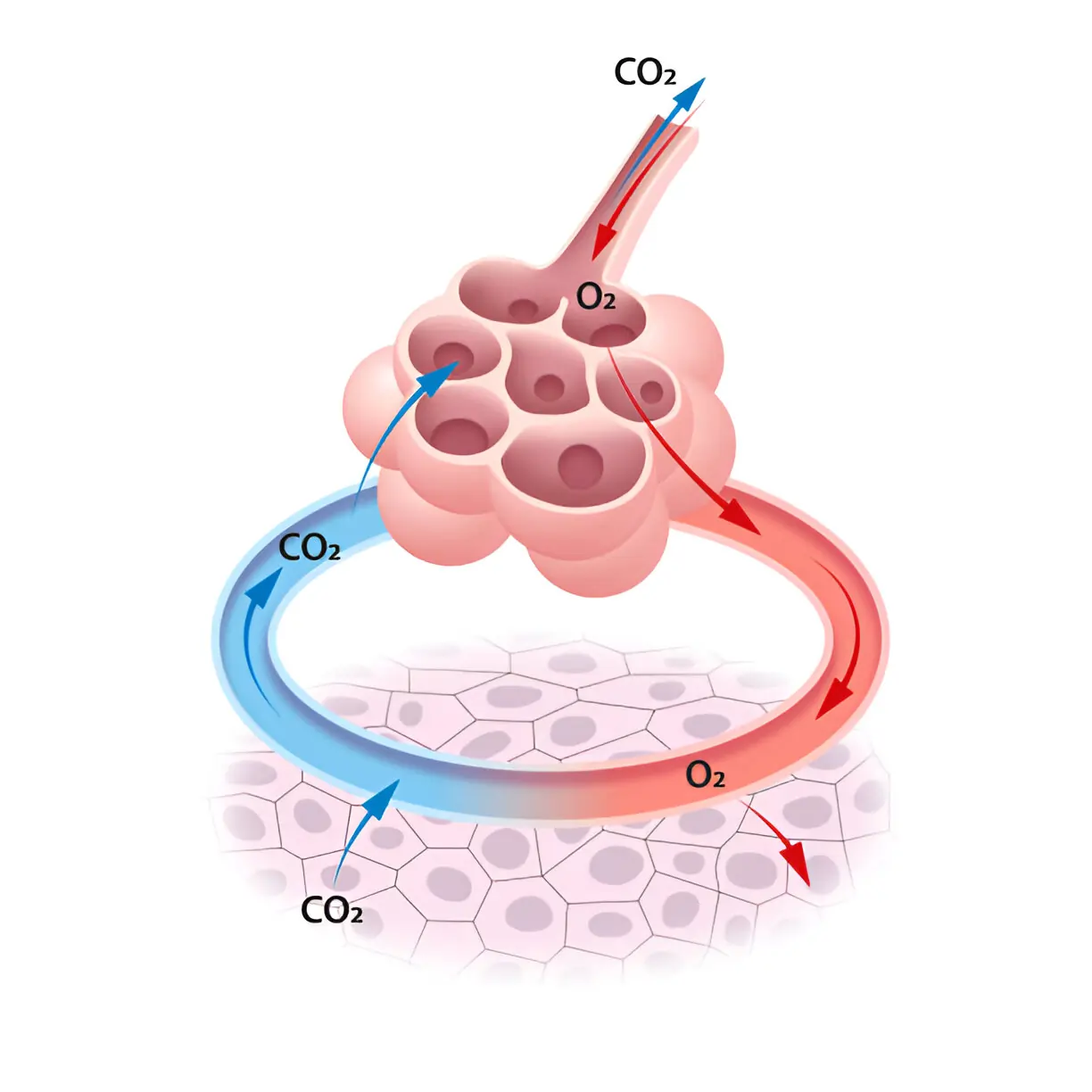Alveoli are microscopic air sacs in the lungs that enable your body to exchange oxygen and carbon dioxide efficiently. These tiny structures play a vital role in breathing, showcasing nature’s elegant design for extracting oxygen and removing waste. Understanding their function highlights their importance to human survival.
What Are Alveoli?
Alveoli are microscopic, balloon-like structures located at the end of the smallest airways in your lungs, called bronchioles. Your lungs contain approximately 300 to 500 million alveoli, creating a surface area roughly equivalent to half a tennis court—all packed into the space of your chest cavity.
Each alveolus measures only about 0.2 millimeters in diameter, yet their collective impact is enormous. These tiny sacs are surrounded by an extensive network of capillaries, the smallest blood vessels in your body. This intimate relationship between alveoli and capillaries creates the perfect environment for gas exchange.
The walls of alveoli are incredibly thin—only one cell thick—which allows gases to pass through easily. This ultra-thin barrier, combined with the massive surface area, makes the lungs incredibly efficient at their primary job: getting oxygen into your bloodstream and removing carbon dioxide from it.
The Structure That Makes Gas Exchange Possible
The alveolar structure represents millions of years of evolutionary refinement. Each alveolus is lined with a thin layer of cells called pneumocytes, which produce surfactant—a substance that prevents the alveoli from collapsing when you exhale.
Surrounding each cluster of alveoli is a dense network of pulmonary capillaries. These tiny blood vessels are so narrow that red blood cells must squeeze through them in single file. This tight arrangement ensures that nearly every red blood cell comes into close contact with the alveolar wall, maximizing the opportunity for gas exchange.
The space between the alveolar wall and the capillary wall is called the respiratory membrane. This membrane is where the actual exchange of gases occurs, and it’s remarkably thin—only about 0.5 micrometers thick. To put this in perspective, it’s roughly 200 times thinner than a human hair.
How Oxygen Transfer Works
When you inhale, fresh air travels down your windpipe, through your bronchi and bronchioles, and finally reaches the alveoli. The air you breathe contains about 21% oxygen, which creates a high concentration of oxygen molecules in the alveolar space.
Meanwhile, the blood flowing through the pulmonary capillaries has a lower concentration of oxygen because your body’s cells have been using it for metabolism. Lung models help illustrate how this concentration difference creates what scientists call a partial pressure gradient.
Oxygen molecules naturally move from areas of high concentration to areas of low concentration through a process called diffusion. The oxygen dissolves in the thin layer of fluid lining the alveolus, passes through the respiratory membrane, and enters the bloodstream.
Once in the blood, oxygen binds to hemoglobin molecules inside red blood cells. Each hemoglobin molecule can carry up to four oxygen molecules, creating an efficient oxygen transport system that delivers this vital gas to every cell in your body.
Carbon Dioxide Removal Process
While oxygen moves into your bloodstream, carbon dioxide follows the opposite path. As your body’s cells produce energy through metabolism, they create carbon dioxide as a waste product. This carbon dioxide must be removed to prevent it from building up to toxic levels.
Blood returning to the lungs through the pulmonary circulation carries carbon dioxide in three forms: dissolved in the blood plasma, bound to hemoglobin, and converted to bicarbonate ions. When this carbon dioxide-rich blood reaches the alveolar capillaries, the gas exchange process reverses.
Carbon dioxide moves from the high-concentration environment in the blood to the lower-concentration environment in the alveoli. The gas crosses the respiratory membrane, enters the alveolar space, and is expelled from your body when you exhale.
This continuous cycle ensures that your blood maintains the proper balance of gases needed for optimal cellular function.
Factors That Influence Gas Exchange Efficiency
Several factors can affect how well your alveoli perform their gas exchange function. The thickness of the respiratory membrane plays a crucial role—any condition that thickens this barrier can impair gas exchange. Diseases like pneumonia or pulmonary edema can cause fluid buildup that interferes with normal diffusion.
Surface area also matters significantly. Conditions like emphysema destroy alveolar walls, reducing the total surface area available for gas exchange. This reduction forces the remaining healthy alveoli to work harder to meet your body’s oxygen needs.
The concentration gradients between the alveoli and blood influence exchange rates as well. At high altitudes, where oxygen concentration in the air is lower, your body must work harder to maintain adequate oxygen levels in your blood.
Blood flow through the pulmonary capillaries affects efficiency too. If blood moves too quickly, there may not be enough time for complete gas exchange. If it moves too slowly, it can limit the overall volume of blood that gets oxygenated.
When Alveolar Function Goes Wrong
Understanding normal alveolar function helps explain what happens when things go wrong. Respiratory diseases often target the alveoli or the surrounding structures, leading to breathing difficulties and reduced oxygen levels in the blood.
Acute respiratory distress syndrome (ARDS) causes inflammation and fluid buildup in the alveoli, creating a barrier to gas exchange. Chronic obstructive pulmonary disease (COPD) can destroy alveolar walls and reduce lung elasticity, making it harder to move air in and out of the lungs.
Even temporary conditions can affect alveolar function. High altitude exposure reduces the partial pressure of oxygen in the alveoli, making gas exchange less efficient until your body acclimates to the new environment.
Conclusion
The alveoli are microscopic structures in the lungs that efficiently extract oxygen from the air and remove carbon dioxide from the blood. They process about 5 liters of air and blood every minute, sustaining every cell in the body.
Read more: Orlando Vacation Ideas: Beyond The Theme Parks For An Amazing Trip – MuskaanHindi
SBOBET Live Betting How To Maximize Your Chances Of Winning
ULIP Uncovered: Is This The Investment-Insurance Hybrid You’ve Been Waiting For? – MuskaanHindi
